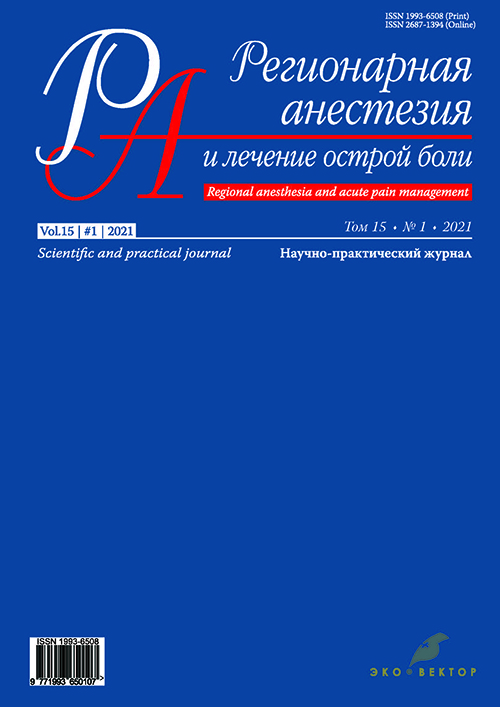Protocol of intravenous lidocaine infusion in the postoperative period in children operated on abdominal organs
- 作者: Felker E.Y.1, Zabolotskii D.V.1, Koriachkin V.A.1
-
隶属关系:
- Saint-Petersburg State Pediatric Medical University
- 期: 卷 15, 编号 1 (2021)
- 页面: 41-47
- 栏目: Original study articles
- ##submission.dateSubmitted##: 09.07.2021
- ##submission.dateAccepted##: 09.07.2021
- ##submission.datePublished##: 15.01.2021
- URL: https://rjraap.com/1993-6508/article/view/75943
- DOI: https://doi.org/10.17816/RA75943
- ID: 75943
如何引用文章
详细
BACKGROUND: Many studies indicate the effectiveness of intravenous lidocaine infusion for perioperative analgesia and treatment of intestinal paresis in adults. In the scientific literature, only a few publications focus on the intravenous infusion of lidocaine in pediatric practice.
The purpose of the work is to increase the effectiveness of the treatment of pain syndrome after operations on abdominal organs in children by creating a protocol for intravenous lidocaine infusion.
MATERIALS AND METHODS: In the development of the clinical protocol, publications included in the databases PubMed, Cochrane, American Society of Anesthesiologists, World Federation of Pediatric Intensive and Critical Care Societies, and American Academy of Pediatrics were considered. The recommendations and standards of care for this problem from the Committee on Pediatric Anesthesiology (“Statement on Practice Recommendations for Pediatric Anesthesia,” 2016), Society for Paediatric Anesthesia Anaesthesiology, and our own materials for our research performed at the St. Petersburg State Pediatric Medical University.
RESULTS: The developed protocol includes 11 provisions, including indications and contraindications to the use of lidocaine infusion, preoperative examination, a list of necessary equipment, the method of infusion, methods of evaluation, and control of postoperative pain syndrome.
CONCLUSIONS: A protocol for the management of children in the early postoperative period using intravenous lidocaine infusion, as an alternative to prolonged epidural blockade and systemic anesthesia, is developed. The authors express confidence that further implementation of the protocol in clinical practice will improve the quality of medical care for children after abdominal surgical interventions.
全文:
作者简介
Evgeny Felker
Saint-Petersburg State Pediatric Medical University
编辑信件的主要联系方式.
Email: felkeru@gmail.com
ORCID iD: 0000-0002-7780-8871
SPIN 代码: 9244-0361
anesthesiologist
俄罗斯联邦, 2, Litovskaya, Saint Petersburg, 194100Dmitry Zabolotskii
Saint-Petersburg State Pediatric Medical University
Email: zdv4330303@gmail.com
ORCID iD: 0000-0002-6127-0798
SPIN 代码: 6726-2571
MD, PhD, DSc
俄罗斯联邦, 2, Litovskaya, Saint Petersburg, 194100Victor Koriachkin
Saint-Petersburg State Pediatric Medical University
Email: vakoryachkin@mail.ru
ORCID iD: 0000-0002-3400-8989
SPIN 代码: 6101-0578
MD, PhD, DSc, Professor
俄罗斯联邦, 2, Litovskaya, Saint-Petersburg, 194100参考
- Ovechkin AM, Yavorovskiy AG. Opioid-free analgesia in surgical practice: a guide for physicians. Moscow: GEOTAR-Media; 2019. (In Russ).
- Makhlouf MM, Garibay ER, Jenkins BN, et al. Postoperative pain: factors and tools to improve pain management in children. Pain Manag. 2019;9(4):389–397. doi: 10.2217/pmt-2018-0079
- Rabbitts JA, Fisher E, Rosenbloom BN, Palermo TM. Prevalence and Predictors of Chronic Postsurgical Pain in Children: A Systematic Review and Meta-Analysis. J Pain. 2017;18(6):605–614. doi: 10.1016/j.jpain.2017.03.007
- Kendall MC, Alves LJC, Suh EI, et al. Regional anesthesia to ameliorate postoperative analgesia outcomes in pediatric surgical patients: an updated systematic review of randomized controlled trials. Local Reg Anesth. 2018;11:91–109. doi: 10.2147/LRA.S185554
- Ovechkin AM, Bayalieva AZ, Ezhevskaya AA, et al. Postoperative analgesia. Guidelines. Alexander Saltanov Intensive Care Herald. 2019(4):9–33. doi: 10.21320/1818-474x-2019-4-9-33 (In Russ).
- Snidvongs S, Nagaratnam M, Stephens R. Assessment and treatment of pain in children. Br J Hosp Med (Lond). 2008;69(4):211–213. doi: 10.12968/hmed.2008.69.4.28975
- Battell E, Hathway GJ. Pain relief in children and adolescents. Pain. 2019;160(8):1687–1688. doi: 10.1097/j.pain.0000000000001613
- Shafi S, Collinsworth AW, Copeland LA, et al. Association of Opioid-Related Adverse Drug Events With Clinical and Cost Outcomes Among Surgical Patients in a Large Integrated Health Care Delivery System. JAMA Surg. 2018;153(8):757–763. doi: 10.1001/jamasurg.2018.1039
- Oderda G. Challenges in the management of acute postsurgical pain. Pharmacotherapy. 2012;32(9 Suppl):6S-11S. doi: 10.1002/j.1875-9114.2012.01177.x
- Zabolotskiy DV, Koryachkin VA. Child and regional anesthesia – What for? Where? And how? Regional Anesthesia and Acute Pain Management. 2016;10(4):243–253. doi: 10.18821/1993-6508-2016-10-4-243-253 (In Russ).
- Weinstein EJ, Levene JL, Cohen MS, et al. Local anaesthetics and regional anaesthesia versus conventional analgesia for preventing persistent postoperative pain in adults and children. Cochrane Database Syst Rev. 2018;6:CD007105. doi: 10.1002/14651858.CD007105.pub4
- Koscielniak-Merak B, Batko I, Fleszar M, et al. Effect of intravenous, perioperative-administered lidocaine on serum levels of endocannabinoids and related N-acylethanolamines in children. Minerva Anestesiol. 2020;86(1):38–46. doi: 10.23736/S0375-9393.19.13703-0
- Koscielniak-Merak B, Batko I, Kobylarz K, et al. Impact of Intravenous, Perioperative-Administrated Lidocaine on Postoperative Serum Levels of Endogenous Opioids in Children. Curr Pharm Des. 2019;25(30):3209–3215. doi: 10.2174/1381612825666190718153209
- Olweny CN, Arnold P. Clinical practice guidelines in pediatric anesthesia: What constitutes high-quality guidance? Paediatr Anaesth. 2020;30(2):89–95. doi: 10.1111/pan.13805
- Cravero JP, Agarwal R, Berde C, et al. The Society for Pediatric Anesthesia recommendations for the use of opioids in children during the perioperative period. Paediatr Anaesth. 2019;29(6):547–571. doi: 10.1111/pan.13639
- Eipe N, Gupta S, Penning J. Intravenous lidocaine for acute pain: an evidence-based clinical update. BJA Education. 2016;16(9):292–298. doi: 10.1093/bjaed/mkw008
- Koryachkin VA, Chupris VG, Cherny AZh, et al. Systemic toxisity of local anesthethics during regional anesthesia in orthopedics and traumatology. Travmatologii i ortopedii Rossii. 2015;75(1):129–135. (In Russ).
补充文件






